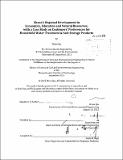Ghana's regional development in economics, education and natural resources, with a case study on customers' preferences for household water treatment & safe storage products
Author(s)
Qiu, Weini
DownloadFull printable version (41.09Mb)
Other Contributors
Massachusetts Institute of Technology. Dept. of Civil and Environmental Engineering.
Advisor
Susan Murcott.
Terms of use
Metadata
Show full item recordAbstract
Ghana is one of the few countries that was re-classified from low-income country to low-middle income country in 2011 by the World Bank (World Bank, 2011a). At the same time, Ghana is still in the process of achieving the Millennium Development Goals (MDGs). This thesis uses the MDGs as a guide and backdrop against which to analyze the relationships between economics, education and natural resources. The analysis helps provide recommendation for regional development in economics, education and natural resources for 10 regions in Ghana. The second part of the thesis uses a case study in the water sector to explore the relationship between the MDG targets for poverty, water accessibility and water quality. The case study is a market survey on Household Water Treatment and Safe Storage products, which seeks to understand customers' preferences for safe water in the home and to find out economic opportunities in this sectors. The author found that each of the economics, education and natural resources indicators: proportion of the population under the poverty line, percentage of population completed primary and secondary schools, selected natural resources (mean time to drinking water source, annual precipitation, oil palm and cocoa) are moderately to strongly correlated with each other. Each region has its own distinct advantages and disadvantages that can help direct priorities for regional development. Among the six HWTS products (Aquatab, CrystalPurTM/Tulip Siphon Water Filter, Kosim Classic, Kosim Deluxe, PUR and LifeStraw@ Family), Kosim Deluxe received the highest total preference score with and without the impact of the price. In general, particle removal products are more popular than the chemical products. Interviewees are concerned about the size (either too big or too small) of the particle removal product and are aware of the side effects of chemical products. MDG Target 7.C is likely to be achieved in urban Tamale shown in this data. The market research shows that HWTS products can contribute to potential post-2015 MDG for water as well as the current MDGs Target 1.A for poverty. Market recommendations are also provided for the six HWTS products.
Description
Thesis (S.M.)--Massachusetts Institute of Technology, Dept. of Civil and Environmental Engineering, 2012. Cataloged from PDF version of thesis. Includes bibliographical references (p. 168-184).
Date issued
2012Department
Massachusetts Institute of Technology. Department of Civil and Environmental EngineeringPublisher
Massachusetts Institute of Technology
Keywords
Civil and Environmental Engineering.